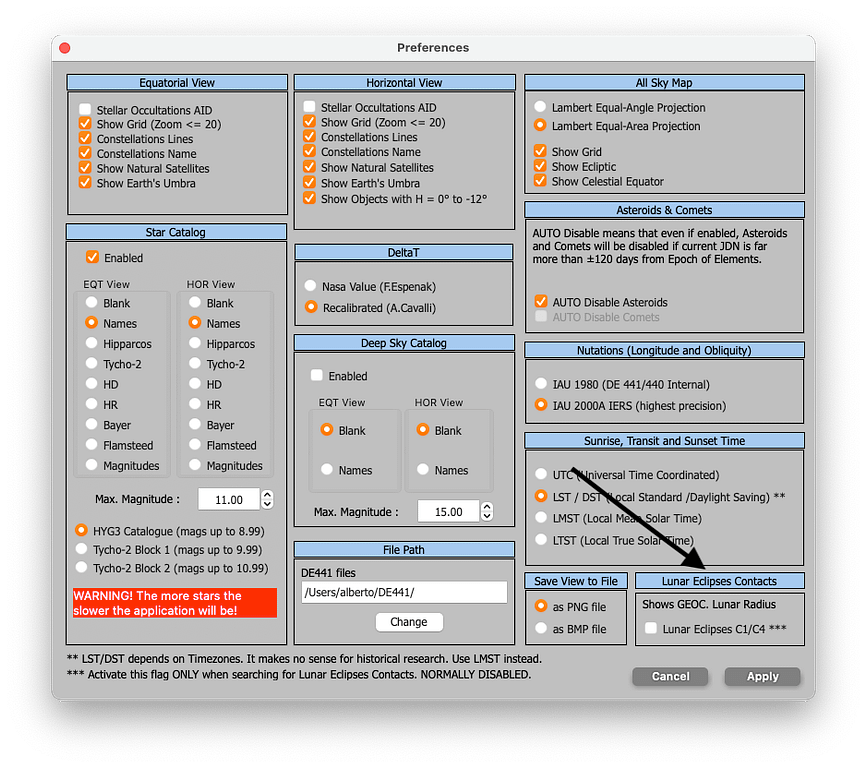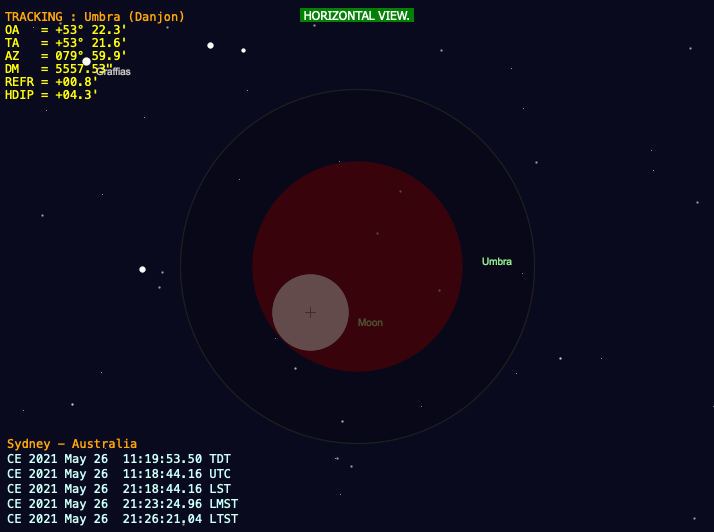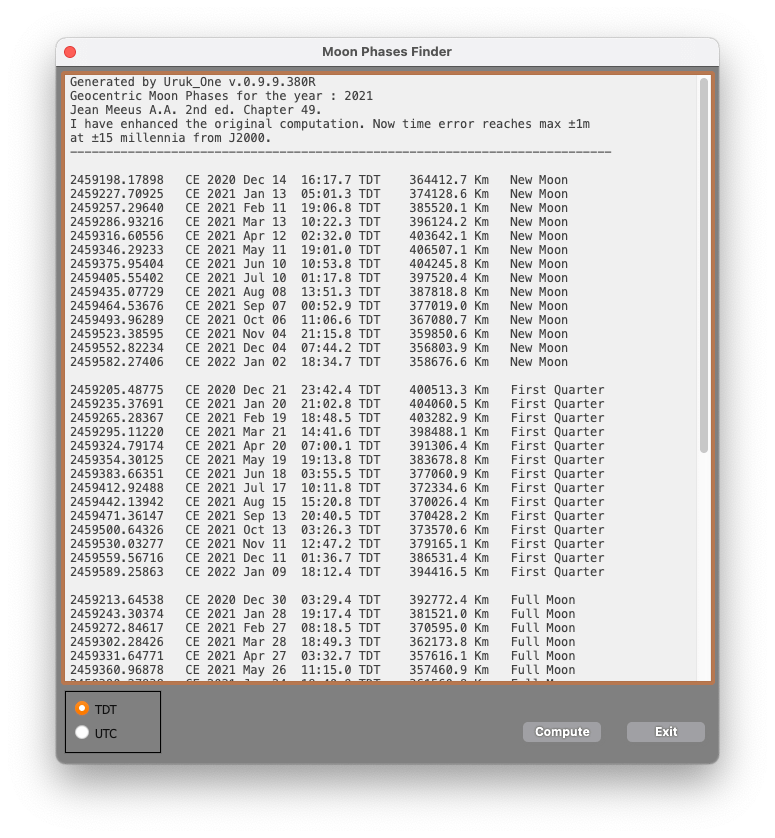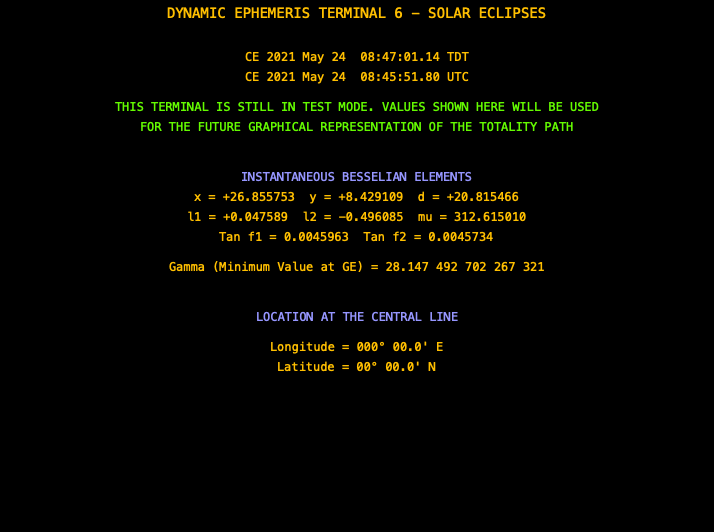(1) – Let’s talk about Lunar Eclipses. I decided to revert back to Danjon’s rules for computing Lunar Umbra and Penumbra diameters and take into account of the displacement from the Center of Figure (COF) of the Moon with respect to the Center of Mass (COM), provided by the ephemeris. This allowed me to compare my result with F. Espenak predictions (those published on EclipseWise, the most recent I suppose) obtaining coincident results. By the way, Espenak proposes an even more rigorous system that takes into account the ellipticity of the shape of the earth’s shadow and the variation of position angle, the Herald-Sinnott method, promising even better results. His post about that is an interesting reading indeed and can be found here. The original paper by Herald and Sinnot can be found here.
(2) – The possibility to have a rigorous search for penumbral, umbral and totality contacts is now given by a new terminal window, T5, where in analytical form, it is explained which values must be achieved for each type of contact. Basically it is the same logic that must be applied to the distance panel already present for the other objects. In order to reach a better graphical fit I added into the Preferences Window a flag showing the Geocentric Moon Radius instead of Topocentric. This flag should be used only during a Lunar Eclipse analysis, then it must be turned off.



(3) – After computing Lunar Standstills, now minimum and maximum of the year are shown.
Generated by Uruk_One v.0.9.9.377R Topocentric Lunar Standstills computed for the year : 2021 Location Name : Paris - France Longitude : + 2° 19' 48.000" Latitude : + 48° 52' 12.00" DEC and RA at True Equinox of Date. Iterative computing by means of DE440/DE441. 2459226.06934 CE 2021 Jan 11 13:39.8 UTC -25.232° 269.568° 2459226.95406 CE 2021 Jan 12 10:53.8 UTC -25.805° 284.029° 2459227.81586 CE 2021 Jan 13 07:34.8 UTC -24.884° 297.885° 2459240.49503 CE 2021 Jan 25 23:52.8 UTC +24.188° 092.506° 2459241.40128 CE 2021 Jan 26 21:37.8 UTC +24.464° 105.724° ........................................... ........................................... ........................................... ........................................... 2459567.64225 CE 2021 Dec 19 03:24.8 UTC +25.171° 086.022° 2459568.53878 CE 2021 Dec 20 00:55.8 UTC +25.941° 098.321° 2459569.44989 CE 2021 Dec 20 22:47.8 UTC +25.544° 110.917° Minimum Standstill : CE 2021 Nov 08 15:26.8 UTC DC = -27.296° Maximum Standstill : CE 2021 Nov 23 02:06.8 UTC DC = +25.981° End computing
(4) – Greatly improved the precision of Lunar Phases computing for distant epochs. The header of the result window should be self explanatory.

(5) – Final improvement to the 30 millennia Canon of Solar and Lunar Eclipses. My number crunching server running Linux has computed again all the events with a resolution of ±1s. This should be now the maximum error of the TDT time indicating the Greatest of Eclipse.
(6) – ASTEROIDS – The new code related to Asteroids is under test. I implemented what’s necessary for downloading via CURL astorb.dat but download times were indecent (minutes, wtf) so decided to say so long to Lowell Observatory (and thanks for all the fish, of course) and use the IAU Minor Planets Center file, MPCORB.DAT, which only takes a few seconds to be picked up.
(7) – Changed the behaviour of PAR(tiality) and TOT(ality) leds. Now when TOT is on, PAR is turned off.
(8) – Terminal 6 is active but temporarily shows only test values I will need later for a graphical representation of total/annular solar eclipses. Values refer to Besselian Elements, Gamma, and the geographical coordinates of the place lying on the Central Line computed at the date shown on the top.


Hi
Once again nice improvements ahead !
On its website, IMCCE/Paris Observatory has computed the lunar eclipse of 26 May 2021 :
https://ssp.imcce.fr/forms/lunar-eclipses/2021-05-26
https://www.imcce.fr/newsletter/html/newsletter.html
For Sydney : https://ssp.imcce.fr/forms/lunar-eclipses/2021-05-26 (zoom + left click)
Lever 26 mai 2021, 06:47:36
P1 26 mai 2021, 08:47:42
O1 26 mai 2021, 09:44:59
T1 26 mai 2021, 11:11:17
M 26 mai 2021, 11:18:44
T2 26 mai 2021, 11:26:10
O2 26 mai 2021, 12:52:27
P2 26 mai 2021, 13:49:46
Coucher 26 mai 2021, 21:19:37
And the Astronomical Almanach website :
http://astro.ukho.gov.uk/eclipse/1112021/L2021May26.pdf
Interesting for checking.
Regards
Hi,
thanks for your appreciation.
Just a note:
As usually happens there are some initial conditions that alter the prediction depending on the source of data.
All timings are referred to UT. Let’s see what values are used:
IMCCE ΔT = 69.367 s
URUK1 ΔT = 69.34 s
ESPENAK ΔT = 70.0 s
HM AA ΔT = 73.9 s
Ok, IMCCE and URUK1 win the run because both use the correct predicted value.This generates an obvious and small difference with timings of eclipse if based on UT.
The radius of Umbra has a huge impact with timings of a lunar eclipse. Few arcsec of difference can lead up to 3-4 minutes gaps in the times. Assuming the Danjon’s model as reference we have:
Umbra Radius at GE:
Espenak (DE430) SDU = 46′ 18.8″
URUK1 (DE440) SDU = 46′ 18.77″
IMCCE (?) SDU = 46′ 19.45″ ± 0.02″
I’m wondering which model is IMCCE using……
EDIT
On the second link you sent there must be a typo on “Maximum de l’éclipse”. It reports 19h 25m as GE.
According to this link: https://ssp.imcce.fr/forms/lunar-eclipses/doc, IMCCE uses Danjon’s method for the umbra radius.
Le calcul du demi-diamètre géocentrique apparent du cône d’ombre et du demi-diamètre géocentrique apparent du cône de pénombre utilise la méthode de Danjon.
Regards
It can therefore be completed:
Umbra Radius at GE:
Espenak (DE430) SDU = 46′ 18.8″
URUK1 (DE440) SDU = 46′ 18.77″
IMCCE (INPOP19A) SDU = 46′ 19.12″
Regards